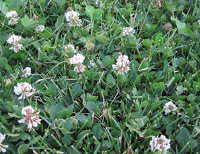
I now have a copy of the U.S. Department of Agriculture Farmers’ Bulletin No. 1677.
Yes, that one. No. 1-6-7-7. “Planting and Care of Lawns”. Published in 1931, updated in 1935.
I now know the truth.
I know that in 1931, when this booklet was originally published, “A beautiful green lawn is the ambition of most home owners… but few are willing to expend the effort necessary for a successful lawn.”
Not much has changed in homeowner’s attitudes in the past 80 years. Too many homeowners want their lawn to look good, but they don’t want to put forth the effort, or don’t know what effort to put forth to make it look good.
I now know that the recommended seed mixture in 1931 for lawns in the northern areas of the country was:
17 parts Kentucky bluegrass
2 parts redtop (probably Agrostis gigantea)
1 part white clover.
By weight.
It’s good to have the evidence that they did put clover in lawn seed mixtures. Who took it out and why? Of course, I know why. It isn’t completely green. But clover is good stuff. I credit clover with keeping the rabbits out of my garden. Plus, clover is good for the soil.
I know now that they also recommended leaving grass clippings on the lawn 80 years ago, unless of course you were mowing very tall grass and the clippings were smothering the lawn.
Why did someone invent lawn mowers with bags to catch lawn clippings? I think I have two, maybe three lawn mower bag attachments up in my attic. As a kid, I hated having to bag the lawn clippings as I mowed. That darn bag would fill up just as I got into the rhythm of mowing. It was disruptive. It was like having a good song stop just as you had become one with the beat.
I now know that in 1931, “the use of chemicals, thus far, has not yet proved a very effective method of controlling lawn weeds”. And furthermore, you just have to keep after your weeds to keep them in check.
I knew you could keep weeds in check. Though I’ve not done a good job of keeping after my weeds, in the lawn or elsewhere, I do believe in this 80 year old advice. Just keep after those weeds, and no matter what, don’t let them set seed.
I now know about lawn care in 1931. And I like it.


Hi,
Wow, I'm thrilled to know that I've been using 1931 advice without even knowing it 🙂
Clover = check
Leaving grass clippings to feed the lawn = check
Not using chemicals to kill weeds = check
I must be old-fashioned at heart.
Good advice. I'm living the 1677 lawn way. But do they mention nutsedge and oxalis? H.
This is wonderful, Carol. It all boils down to your definition of weed. For me, there is only one, crabgrass, and it gets pulled up before allowed to set seed. In the garden beds, paths or lawn, crabgrass is the enemy. But those grass clippings added to the compost pile are sweet.
I love the 1931 lawn care regimen! But, there really aren't many weeds living in my lawnette that bother me….and I am thinking that I will plant more Lyreleaf sage, Wild Petuna and sedges to make it even more weedy! gail
I have to say that unless it's a sticker bush, or a renegade poplar (from a neighbor's tree) we don't care about the weeds in our lawn. In fact, I sort of like them. We've got violets, buttercups, clover, some sort of spiky purple flower that I need to look up, and the ubiquitous dandelion. As far as I'm concerned, they add color to the lawn and spice it up.
And the bees love them.
Thanks for posting this! I had read in several places that clover was standard in lawns before the pesticide industry convinced us that it was a weed – but I'd never seen hard evidence or an actual reference before! This is very helpful.
Thanks,
Janice
I also follow the 1931 techniques. I think it might have been Warren Schultz in his book, A Man's Turf, who explained that it wasn't until after WWII that all the chemical fertilizers and herbicids came into wide use because companies that had been making materiel for the military now needed a new market – the home market.
wow, it is really interesting that in less than 100 years the popular recommendations for keeping a healthy lawn have not only done a 180, they are starting to turn the full 360! Our grandparents DID know what they were doing 🙂
I guess I hadn't given much positive thought to clover in my lawn… I've been hard at the crab grass, though!! Can't keep it all from going to seed, but I can do my best! 🙂 Yours was an interesting post.
Of course it wasn't until about 1945 that your evil friend and mine, Monsanto, introduced the arsenal of lawn chemicals that forced the USDA to re-update the update to the 'care of lawns' bulletin. And life in suburbia was never the same….